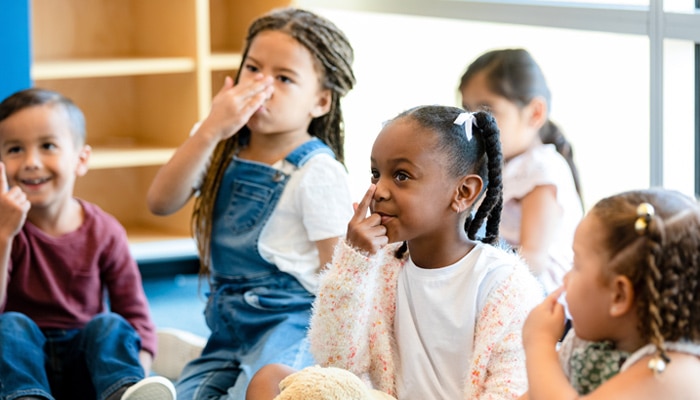While we believe that the books and resources recommended may be of value to you, keep in mind that these are suggestions only and you must do your own due diligence to determine whether the materials are appropriate and suitable for your use. PNC has no sponsorship or endorsement agreement with the authors or publishers of the materials listed.
MY FIVE SENSES

It Smells
Children will learn about the sense of smell.

Lesson Objective
Children will learn about their nose and explore the sense of smell by describing and identifying different smells.
Science
What You'll Need
- Opaque plastic containers (empty butter, cream cheese, or cottage cheese containers) – 1 per scented item
- Cotton balls – 15
- Vinegar – 2 tablespoons
- Lemon juice – 2 tablespoons
- Vanilla flavoring – 2 tablespoons
- Almond flavoring – 2 tablespoons
- Cocoa beans or a few pieces of chocolate
- Coffee beans – 12
- Orange peel – from 1 orange
- Banana peel – from 1 banana
- Apple peel – from 1 apple
- Mint leaves – 4–6
- Cinnamon sticks – 2
- Scissors (adult use)
What To Do
Note: To prepare the containers, make several holes in the lid of each container with scissors. Put the pieces of banana peel, cinnamon sticks, mint leaves, etc. in individual containers and close the lids. For the liquid items (lemon juice, vinegar, and flavorings) soak two to three cotton balls with the liquid, place each flavor in individual containers, and close the lids.
- Begin with a container with a familiar item in it, such as the apple or the banana. Show the children the container and tell them that there is an item inside.
- Pass the container around and ask the children if they can guess what is inside without opening the container.
- Observe the children as they examine the container to see if they are shaking it, turning it over, trying to open it, or sniffing it.
- As they begin to guess what is inside, ask the children how they are making their guesses.
- Open the container and show them what is inside. Continue the process for each of the containers. For the liquid items, show the children the bottle it came from or a picture of a lemon, almond, or vanilla beans.
Resources
Home School Resources
Home educators: use these printable lesson PDFs to teach this lesson to your home schoolers. They're available in English and Spanish.
Content Provided By
Common Core State Standards Initiative – These lessons are aligned with the Common Core State Standards ("CCSS"). The CCSS provide a consistent, clear understanding of the concepts and skills children are expected to learn and guide teachers to provide their students with opportunities to gain these important skills and foundational knowledge [1]. Visit the CCSS


